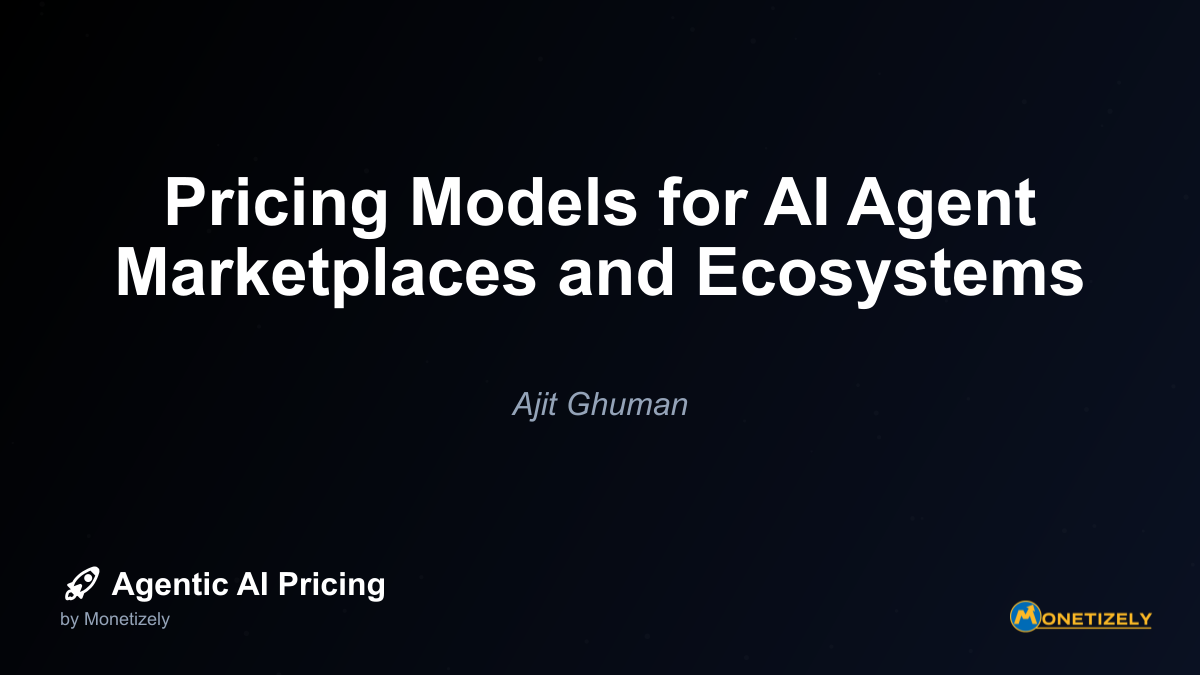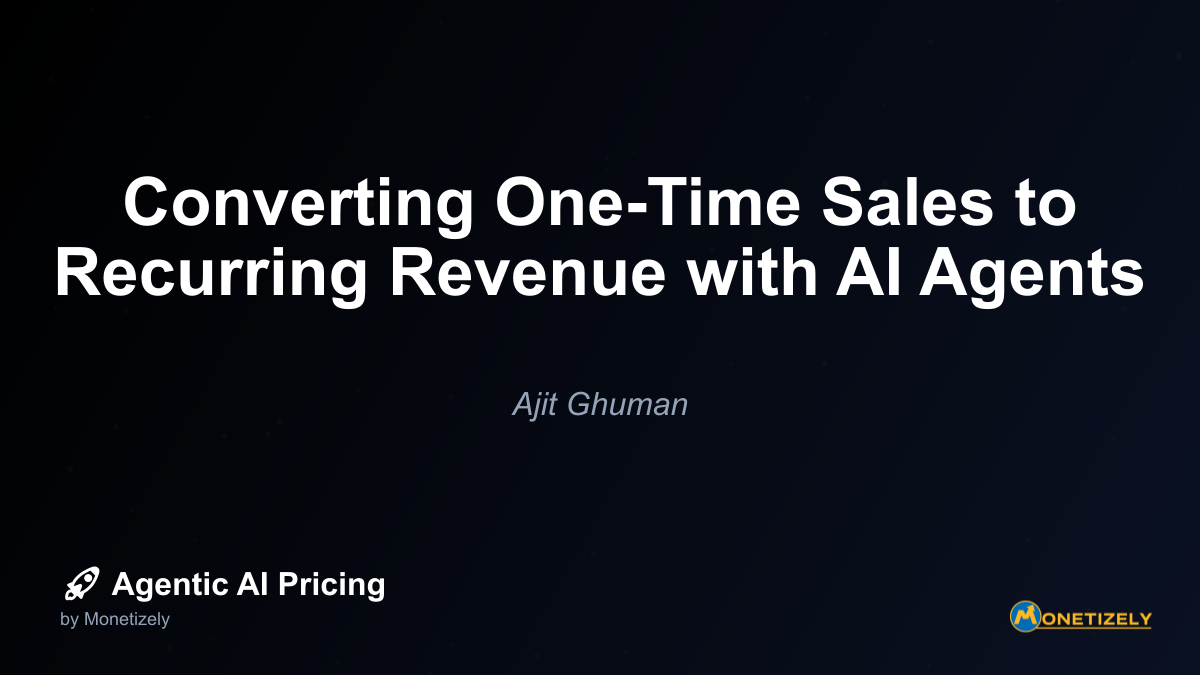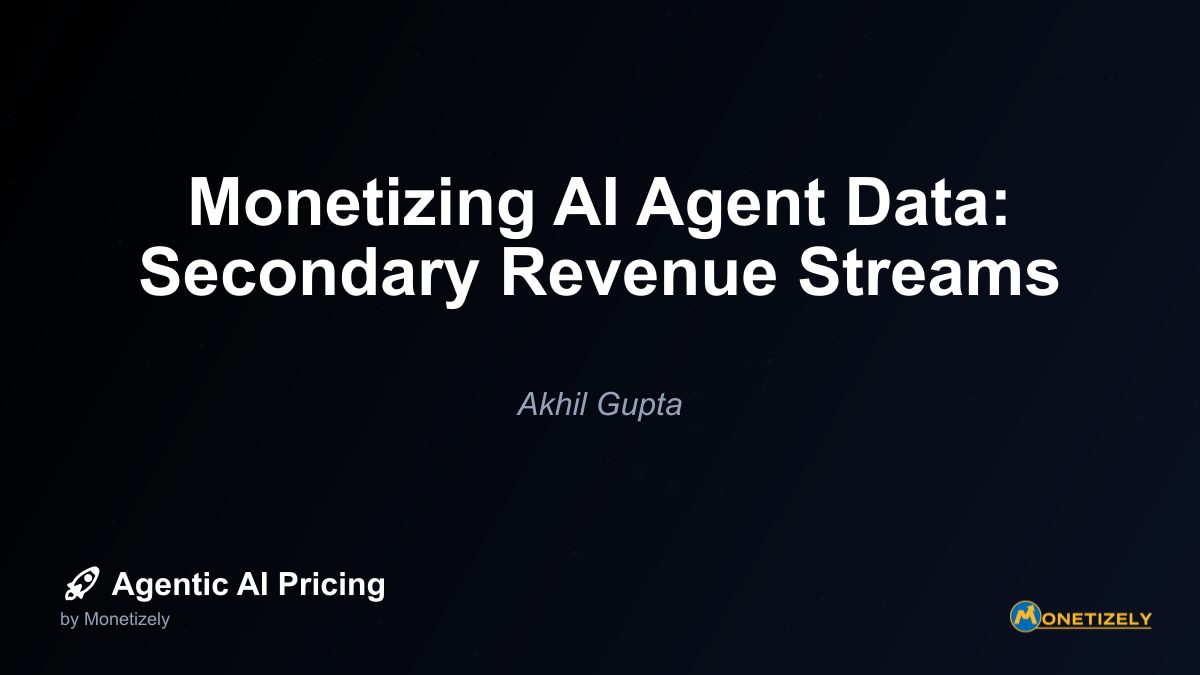· Ajit Ghuman · Business Models · 14 min read
Pricing Models for AI Agent Marketplaces and Ecosystems
AI and SaaS Pricing Masterclass
Learn the art of strategic pricing directly from industry experts. Our comprehensive course provides frameworks and methodologies for optimizing your pricing strategy in the evolving AI landscape. Earn a professional certification that can be imported directly to your LinkedIn profile.

The AI agent marketplace landscape is rapidly evolving, creating new opportunities for platforms that connect AI agent developers with customers. As these ecosystems mature, innovative pricing and monetization strategies are emerging to balance the needs of all stakeholders while driving sustainable growth.
The Current State of AI Agent Marketplace Economics
AI agent marketplaces function as multi-sided platforms connecting three key participants: developers who create AI agents, platform providers who build and maintain the marketplace infrastructure, and end users who consume agent services. The economic viability of these ecosystems depends on creating value for all participants while establishing sustainable revenue models.
The market for AI agents is experiencing explosive growth, with projections indicating a compound annual growth rate of 45-46% through 2030. According to recent industry reports, the global AI agent market is expected to reach $50 billion by 2030, with more aggressive forecasts suggesting values up to $236 billion by 2034. This rapid expansion is driving innovation in pricing and monetization approaches as platforms seek to capture value while nurturing ecosystem growth.
Dominant Pricing Models in Today’s Marketplaces
Current AI agent marketplaces employ several core pricing structures, often in combination:
Transaction fees with network effects: Platforms typically charge fees on transactions between developers and users. The strength of network effects influences sustainable fee levels—marketplaces with robust networks of quality agents and active users can maintain higher transaction fees (20-30%), while emerging platforms with weaker network effects charge lower rates (10-15%).
Usage-based pricing: Instead of flat subscriptions, many marketplaces employ pay-per-task, pay-per-output, or consumption-based models that align costs with actual usage. This approach provides flexibility for users while creating predictable revenue streams tied to platform utilization.
Token-based economies: Some platforms implement token systems where users purchase tokens to access agent services, and developers earn tokens as they improve their agents. This creates a self-regulating economy that incentivizes quality and performance.
Outcome-based payments: Advanced marketplaces are shifting toward models that tie costs to measurable business outcomes rather than raw usage. For example, support automation tools might charge only when AI agents successfully resolve customer issues.
Subscription tiers: Traditional subscription models remain common, offering different service levels with varying features, usage limits, and support options. These often incorporate usage-based or user-based scaling components.
The most successful marketplaces typically employ hybrid approaches, combining multiple pricing elements to balance predictability with flexibility and align costs with delivered value.
Case Studies: Successful AI Agent Marketplace Implementations
Several pioneering platforms demonstrate effective pricing and monetization strategies in the AI agent ecosystem:
HuggingFace’s Model Hub
HuggingFace has established a thriving marketplace by balancing open access with strategic monetization:
- Pricing and Revenue: The platform offers free access to open-source AI models while monetizing through paid inference API usage, enterprise support packages, and specialized solutions for high-volume users.
- Developer Incentives: By providing a large community and developer tools with visibility, HuggingFace encourages contributions through exposure and revenue opportunities tied to API usage and enterprise deals.
- Key Success Factor: This multi-tiered approach balances free access with monetization to sustain ecosystem growth while providing clear pathways for developers to generate revenue.
OpenAI’s GPT Store
OpenAI has implemented a commission-based revenue model that encourages quality GPT creation:
- Pricing Model: Combines commission-based revenue for popular GPT creators with enterprise access tiers featuring customized pricing. Usage-based billing for compute resources and premium placement opportunities provide additional monetization channels.
- Revenue Structure: Revenue sharing with developers serves as a core aspect, encouraging quality GPT agent creation while facilitating monetization for both the platform and creators.
- Key Success Factor: The marketplace model fosters an ecosystem where developers can earn based on agent popularity and usage, creating alignment between platform success and developer incentives.
Vertical-Specific AI Agent Solutions
Industry-specific AI agents are commanding premium pricing aligned with their financial impact:
- Pricing Approach: Specialized agents in sectors like sales, legal, and finance implement pricing models that reflect the high value they deliver per seat or user.
- Case Example: An enterprise client leveraging AI agent sales tools saw a 35% increase in demo requests and a 27% boost in proposals submitted. These AI agents personalized outreach, shortening the sales cycle from 120 days to 90 days and reducing sales and marketing costs by 12%, representing $230,000 in quarterly savings.
- Key Success Factor: By demonstrating clear ROI and business impact, these specialized agent marketplaces can justify premium pricing while providing compelling case studies that drive further adoption.
These case studies highlight the importance of aligning pricing with value delivery and creating sustainable incentive structures that benefit all ecosystem participants.
Multi-Sided Market Dynamics in AI Agent Ecosystems
The success of AI agent marketplaces depends on effectively managing the complex dynamics between developers, platform providers, and end users. These multi-sided markets thrive on cross-side network effects—the value for one group increases as the size and quality of the other groups grow.
Balancing Participant Incentives
Each participant in the ecosystem has distinct needs and motivations:
Developers seek visibility, technical infrastructure, fair compensation, and growth opportunities. They are incentivized to create innovative, high-performance AI agents when platforms reward quality and user satisfaction through mechanisms like quality-based pricing incentives, premium tiers, and performance-based commissions.
Platform providers must balance ecosystem growth with profitability. They typically use a mix of base access fees (including free tiers to encourage adoption), transaction fees that vary by agent complexity or volume, and value-added fees for certification, better visibility, or analytics. Many platforms initially subsidize one side (commonly end users) to build scale and charge the other side (developers or enterprises) premium fees.
End users want reliable, valuable agents at reasonable prices. They benefit from a diverse agent ecosystem that improves with more developers and better platform support. Platforms often offer free or tiered pricing to encourage larger user bases, which in turn attracts and retains developers.
Effective Pricing Strategies for Multi-Sided Markets
Several pricing approaches have proven effective in balancing the needs of all participants:
Multi-dimensional fees: Combining base platform fees, transaction-based fees, and value-added service fees creates balanced revenue streams that support platform maintenance and ecosystem incentives.
Progressive value capture: Platforms frequently start with lower take rates to encourage developer participation and gradually increase fees as the platform matures and delivers more value.
Transparency and flexibility: Clear communication of fee structures, revenue calculators, and allowing developers choice in monetization models (e.g., freemium, subscriptions, performance rewards) fosters trust and ecosystem health.
Quality alignment: Linking incentives to agent quality and user satisfaction—for instance, reduced fees for top-rated agents—drives improvements in the user experience and long-term sustainability.
The most successful marketplaces recognize that different sides of the market may require different pricing approaches, and they design their monetization strategies accordingly. For example, enterprise customers might pay premium fees for specialized agents with service guarantees, while individual users might access a more limited set of agents at lower cost points.
Technical Considerations for AI Agent Marketplace Pricing
Implementing effective pricing models for AI agent marketplaces involves addressing several technical challenges and considerations:
Cost Variability and Margin Pressure
AI agents incur real-time variable costs (e.g., per prompt, per API call) that fluctuate with usage and underlying infrastructure like large language models, making predictable pricing difficult. This variability can create margin pressure, especially when platforms offer fixed-price subscriptions but face fluctuating costs based on usage patterns.
To address this challenge, platforms need robust usage tracking and cost allocation systems that can accurately measure and attribute costs at a granular level. Many implement real-time monitoring and dynamic pricing adjustments to maintain sustainable margins while providing predictable pricing for users.
Usage Measurement and Metrics
Determining what usage or outcome metrics to base pricing on is technically challenging. Usage-based pricing is flexible but can be unpredictable for users; outcome-based pricing is ideal but complex to define and measure.
Successful platforms invest in sophisticated analytics and measurement systems that can:
- Track fine-grained usage metrics (tokens, API calls, compute time)
- Measure business outcomes attributable to agent actions
- Provide transparency to both developers and users
- Support dynamic pricing adjustments based on real-time data
Integration and Interoperability
Many AI agents run on foundation models controlled by relatively few firms, creating potential bottlenecks or “walled gardens” that could limit interoperability and competition downstream. Advanced architectures like the “agentic AI mesh” promote vendor neutrality, modularity, and governed autonomy, enabling diverse agents to collaborate flexibly across platforms and avoiding vendor lock-in.
Platforms that embrace open standards and interoperability can create more value for all participants while avoiding the technical limitations of closed ecosystems. This approach also supports more flexible pricing models that can adapt to evolving technology landscapes.
Balancing Human and AI Roles
Pricing models must consider how much AI augments versus replaces human labor, which influences customer willingness to pay and cost structures. Platforms need to carefully assess the value proposition of their agents—whether they’re fully autonomous, human-in-the-loop, or primarily augmentative—and design pricing accordingly.
Technical systems that can measure the degree of human involvement and adjust pricing dynamically based on automation levels are becoming increasingly important as AI capabilities evolve.
Regulatory Considerations and Ethical Implications
As AI agent marketplaces mature, they face growing regulatory scrutiny and ethical considerations that impact pricing strategies:
Transparency and Fairness
Transparency is essential to comply with emerging regulations and build trust. Pricing structures, including transaction fees, subscription tiers, and value-added services, should be clearly communicated to developers and users to avoid regulatory scrutiny related to unfair trade practices or hidden costs.
Fairness and bias mitigation require adherence to anti-discrimination laws by ensuring pricing algorithms do not produce biased outcomes toward protected groups (race, gender, socioeconomic status). This involves regularly auditing data and algorithms to identify and mitigate biases.
Data Privacy and Security
Data privacy and security laws influence how customer and market data used in dynamic pricing models must be handled, demanding compliance with frameworks like GDPR or CCPA. Platforms must implement robust data governance frameworks that protect user information while still enabling effective pricing optimization.
Ethical Pricing Considerations
Several ethical dimensions should inform AI agent marketplace pricing:
Transparency and Explainability: Ethical AI pricing mandates that users and stakeholders understand how prices are set. Explainable AI (xAI) principles should be applied to provide meaningful explanations tailored to different audiences and ensure algorithmic decisions can be audited and trusted.
Fair Value Distribution: Pricing strategies should promote fairness between platforms and AI developers to sustain innovation and ecosystem growth. Evidence shows developers retain 70-85% of value fosters higher innovation and participation.
Accessibility and Inclusivity: Ethical pricing should balance profit with accessibility, for example, by offering free or lower-cost tiers to startups or smaller businesses and premium tiers for advanced features. This broadens adoption while maintaining revenue.
Sustainability: Pricing models might consider environmental impacts, such as the energy costs of running AI infrastructure, integrating sustainability into ethical pricing considerations.
Risk Management Strategies
To navigate regulatory and ethical challenges, platforms should implement several risk management strategies:
Dynamic and Continuous Monitoring: AI marketplaces should continuously analyze market conditions, customer segments, and competitor pricing to adapt pricing models dynamically while maintaining fairness and transparency.
Transparent Fee Structures: Providing clear fee disclosures, revenue calculators for developers, and flexible pricing models mitigate risks of developer dissatisfaction and developer churn.
Explainability Audits: Regular audits ensuring pricing algorithms meet transparency and fairness standards reduce reputational and regulatory risks associated with opaque or biased pricing decisions.
By proactively addressing these considerations, AI agent marketplaces can build trust with all stakeholders while avoiding regulatory pitfalls that could undermine their business models.
Frameworks for Optimizing AI Agent Marketplace Pricing
Companies setting up and optimizing pricing for AI agent marketplaces should adopt comprehensive frameworks that address both strategic and tactical considerations:
Core Pricing Models Framework
The foundation of an effective pricing strategy typically includes multiple pricing approaches:
Per-Agent Pricing (FTE Replacement): Charges a fixed monthly fee per AI agent, positioning the agent as a digital employee that replaces headcount. This model offers predictable costs and aligns price with perceived labor savings. It works well when agents perform broad workflows that would otherwise require hiring staff.
Per-Conversation Pricing: Charges per interaction with the AI agent. This is easy to understand and budget for but may become costly for high-volume use cases.
Outcome-Based Pricing: Prices tied to successful task completion or outcomes realized, directly aligning cost with delivered value but needing clear success metrics.
Token-Based Consumption: Charges based on tokens processed (input/output text length), providing granular and usage-based pricing but can be complex to predict.
The most effective approach is typically a balanced multi-component pricing framework that incorporates elements of multiple models, such as:
- Base access fees (including free tiers with usage caps to attract users)
- Transaction fees (differentiated based on agent complexity or volume)
- Value-added service fees (certification, featured listings, advanced analytics)
This multi-dimensional approach can balance revenue stability and flexibility, serving both the platform and ecosystem participants.
Strategic Implementation Framework
Beyond the basic pricing models, platforms should consider a phased approach to monetization that balances short-term revenue with long-term ecosystem growth:
Launch Phase: Prioritize building agent supply and user demand with low or zero fees to reduce friction. Focus on creating network effects and demonstrating value before aggressive monetization.
Growth Phase: Introduce basic monetization via transaction fees or subscriptions. Begin capturing value while continuing to incentivize ecosystem expansion.
Maturity Phase: Optimize with sophisticated pricing tiers, enterprise offerings, and specialized services. Leverage established network effects to maximize sustainable value capture.
Throughout these phases, platforms should leverage network effects by designing pricing that fosters growth of both agent creators and users. The marketplace’s value increases exponentially with participation, so delaying full monetization until critical mass (>10,000 monthly active users) can support 30% higher long-term growth.
Quality and Innovation Incentives
Successful frameworks include mechanisms to incentivize quality and innovation beyond volume-based metrics:
- Implement quality-based pricing incentives, like premium tiers or reduced platform fees for high-quality, well-rated agents
- Create performance-based commissions or revenue share bonuses for agents that deliver exceptional outcomes
- Provide enhanced visibility and promotion for top-performing agents
By rewarding quality and innovation, platforms can create virtuous cycles that improve the overall ecosystem value while justifying premium pricing.
Future Trends in AI Agent Marketplace Pricing (2025-2030)
The future of AI agent marketplace pricing is moving away from flat subscriptions toward more flexible, usage-based, and token-based models. Several key trends are emerging:
Tokenized Economies and Micro-Transactions
The use of blockchain-style or native tokens representing service credits or rewards is under experimentation, promoting granular scalability and developer incentives. These tokenized economies enable:
- Pay-per-task or pay-per-output microtransactions
- Agent-specific tokens that grant and track access to AI agent services
- Token-based incentive structures that reward quality improvements
This approach creates more fluid value exchange within ecosystems while providing fine-grained control over incentives and rewards.
Mobile-First and Ubiquitous AI Agents
AI agents are becoming ubiquitous on mobile devices, with generative AI embedded directly in smartphones fueled by new operating systems and advanced AI-specific chips. This enables voice- or AR-invoked agents anytime and anywhere, supporting more dynamic, personalized AI usage and reinforcing granular, pay-as-you-go pricing models that mirror on-demand digital economies.
Vertical Specialization and Premium Pricing
As the market matures, we’re seeing increasing vertical specialization with industry-specific AI agents commanding premium pricing aligned with their financial impact. These specialized agents—focused on sectors like finance, healthcare, e-commerce, and legal services—can justify higher prices based on the specific business value they deliver, creating opportunities for premium marketplace segments.
Outcome-Based Pricing Dominance
The shift from pricing driven by compute or API volume toward pricing linked to outcomes such as saved time, improved accuracy, or revenue impact is accelerating. This trend better captures AI agent value and aligns incentives between platforms, developers, and users. Advanced measurement and attribution systems are making this approach increasingly feasible at scale.
Interoperable Agent Ecosystems
The emergence of interoperable agent ecosystems, where agents from different developers and platforms can seamlessly work together, is creating new pricing challenges and opportunities. These ecosystems enable more complex workflows and value creation but require sophisticated pricing models that can account for value contributions from multiple agents working in concert.
Implementing Effective AI Agent Marketplace Pricing: Practical Steps
For organizations building or optimizing AI agent marketplaces, several practical steps can help establish effective pricing:
Conduct comprehensive market research: Analyze competitor pricing models, customer willingness to pay, and developer expectations to establish baseline pricing parameters.
Define clear value metrics: Identify and implement measurement systems for the specific value your marketplace and agents deliver, whether that’s time savings, cost reduction, revenue enhancement, or other outcomes.
Build flexible pricing infrastructure: Implement technical systems that can support multiple pricing models simultaneously and adapt as your marketplace evolves.
Start with low friction: Consider minimizing upfront fees and monetization to accelerate network effects, then gradually introduce more sophisticated pricing as your ecosystem matures.
Establish transparent developer economics: Create clear communication, calculators, and tools
Co-Founder & CEO
Ajit is the author of Price To Scale, a top book on SaaS Pricing and is the Founder of Monetizely. Ajit has led and worked in pricing and product marketing at firms like Twilio, Narvar and Medallia. His work has been featured in Forbes and VentureBeat. Ajit regularly consults with software companies from Seed stage to post-IPO on pricing strategy. Ajit is also a highly-rated co-instructor for 'The Art of SaaS Pricing and Monetization' on Maven.
Pricing Strategy Audit
Let our experts analyze your current pricing strategy and identify opportunities for improvement. Our data-driven assessment will help you unlock untapped revenue potential and optimize your AI pricing approach.




